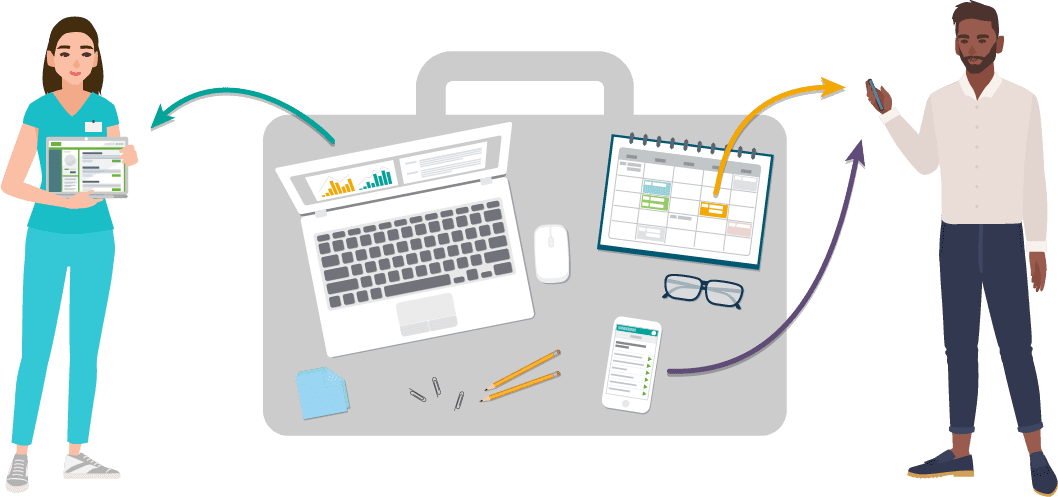Working in a home-based environment often presents many challenges. One of these challenges is determining how to properly manage waste, especially medical waste.
There is a proper way to manage medical waste in the home setting.
It includes identifying medical waste items, following the regulations that govern medical waste disposal in the home, and acknowledging the proper procedure for the handling and disposal of contaminated sharps, medications, and other regulated medical waste, such as personal protective equipment, or PPE.
What is Medical Waste?
The Environmental Protection Agency, or EPA, and the Occupational Safety and Health Administration, or OSHA, identify medical waste as healthcare waste that is potentially contaminated by blood, body fluids, and other potentially infectious materials, commonly abbreviated OPIM. It is also called regulated medical waste.
Medical waste can be any of the following:
- Blood
- Body fluids contaminated with infectious material
- Contaminated items that would release blood or other potentially infectious materials if compressed
- Items caked with dried blood or other potentially infectious materials that are capable of being released during handling
- Contaminated sharps
- Pathological and microbiological waste contaminated with blood or other potentially infectious materials
Who Regulates Medical Waste?
Medical waste management is primarily regulated by state health and environmental departments as well as federal agencies such as the:
- Centers for Disease Control, or CDC
- Occupational and Health Administration, or OSHA
- Food and Drug Administration, or FDA
Your practice for disposing of medical waste is determined by those agencies, as well as local ordinances and your own organization’s specific policies and procedures.
Medical Waste in the Home
All medical waste has the potential to carry the human immunodeficiency virus, or HIV, the hepatitis B or C viruses, and other transmittable infectious agents. Examples of medical waste that you might encounter in the home include discarded:
- Bandages and dressings soiled with blood and/or body fluids
- Used gloves and other PPE
- Needles
- Lancets and glucose strips
- Sharps containers
- Urinary catheter sets
- Intravenous, or IV catheters
- Cotton swabs used for wound care
- Tongue depressors
- Tissues with sputum or other body fluids
- Filled biohazard bags
- Specimen containers and bags, such as lab vials
Your Responsibility
It is your responsibility to be aware of which items in the home are considered medical waste and know how to properly dispose of them. All medical waste must be safely:
- Segregated
- Handled
- Labeled
- Stored
- Disposed of
Handling and Disposing Medical Waste
OSHA requires that your organization have a written policy and procedure program that eliminates or minimizes your risk for exposure to blood and other potentially infectious materials.
Be sure you are familiar with your organization’s program, called the Exposure Control Plan. If you do not know where this is located, ask your supervisor!
Labels and Color Coding
There are universally accepted labels and colors to indicate a biohazard item. A warning label that has the universal biohazard symbol and the word biohazard must be on any container that contains regulated medical waste. The background should be fluorescent orange or orange-red and the symbol should be in a contrasting color.
Containers for Medical Waste
State laws and local ordinances will designate the regulations for disposal of medical waste. There are additional regulations put forth by OSHA that specify the characteristics of all containers for medical waste.
Sharps
In addition to the OSHA standards for all regulated waste containers, sharps containers must be puncture-resistant and leak proof on the sides and bottom.
Approved sharps containers may be made of cardboard or plastic and should be placed in an area closest to the immediate area where the sharps are used.
They should remain upright at all times and be easily accessible. Check with your Exposure Control Plan to identify the practice standards you should follow and be sure to replace sharps containers routinely to avoid overfilling.
Your organization will have a policy and procedure for how to dispose of filled sharps containers. Options for disposal include drop boxes at designated collection sites, mail-back programs, pick-up services, and sometimes disposal in the common trash.
You should be aware of the local ordinances, state and federal law, and organizational policy and procedure for sharps container transport and disposal and follow them accordingly.
Medication Disposal
Usually medications are considered to be “hazardous waste” when they contain certain toxic chemicals or have characteristics that make them potentially dangerous to the community.
Medications should never be dumped in a place that might endanger others, such as on the ground outside, in the household trash, down the sink, or in the toilet.
Your organization will specify the professionals responsible for medication disposal and destruction and the procedures for the process.
State and local laws will indicate the parameters for medication disposal and trump any federal regulations. Be sure your actions are always within the scope of your professional practice.
Your Responsibilities
Check with your organizational policy to determine your responsibilities regarding the handling and disposal of all medical waste in the home. Remember to be certain you are operating within the scope of your own professional practice at all times and following your own organization’s Exposure Control Plan. It is always best to be safe rather than sorry!

Compliance Toolkit
Download our Compliance Toolkit to learn four key elements to stay compliant and receive five free white papers, webinars and more!
Download Toolkit →





